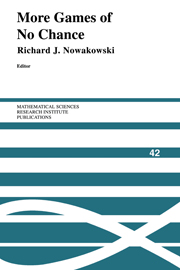Book contents
- Frontmatter
- Contents
- Preface
- The Big Picture
- Idempotents Among Partisan Games
- On the Lattice Structure of Finite Games
- More Infinite Games
- Alpha-Beta Pruning Under Partial Orders
- The Abstract Structure of the Group of Games
- The Old Classics
- Higher Nimbers in Pawn Endgames on Large Chessboards
- Restoring Fairness to Dukego
- Go Thermography: The 4/21/98 Jiang-Rui Endgame
- An Application of Mathematical Game Theory to Go Endgames: Some Width-Two-Entrance Rooms With and Without Kos
- Go Endgames Are PSPACE-Hard
- Global Threats in Combinatorial Games: A Computation Model with Applications to Chess Endgames
- The Game of Hex: The Hierarchical Approach
- Hypercube Tic-Tac-Toe
- Transfinite Chomp
- A Memory Efficient Retrograde Algorithm and Its Application to Chinese Chess Endgames
- The New Classics
- The 4G4G4G4G4 Problems and Solutions
- Experiments in Computer Amazons
- Exhaustive Search in Amazons
- Two-Player Games on Cellular Automata
- Who Wins Domineering on Rectangular Boards?
- Forcing Your Opponent to Stay in Control of a Loony Dot-and-Boxes Endgame
- 1 x n Konane: A Summary of Results
- 1-Dimensional Peg Solitaire, and Duotaire
- Phutball Endgames Are Hard
- One-Dimensional Phutball
- A Symmetric Strategy in Graph Avoidance Games
- A Simple FSM-Based Proof of the Additive Periodicity of the Sprague-Grundy Function of Wythoff's Game
- Puzzles and Life
- The Complexity of Clickomania
- Coin-Moving Puzzles
- Searching for Spaceships
- Surveys
- Unsolved Problems in Combinatorial Game Theory: Updated
- Combinatorial Games: Selected Bibliography With A Succinct Gourmet Introduction
Combinatorial Games: Selected Bibliography With A Succinct Gourmet Introduction
Published online by Cambridge University Press: 29 May 2025
- Frontmatter
- Contents
- Preface
- The Big Picture
- Idempotents Among Partisan Games
- On the Lattice Structure of Finite Games
- More Infinite Games
- Alpha-Beta Pruning Under Partial Orders
- The Abstract Structure of the Group of Games
- The Old Classics
- Higher Nimbers in Pawn Endgames on Large Chessboards
- Restoring Fairness to Dukego
- Go Thermography: The 4/21/98 Jiang-Rui Endgame
- An Application of Mathematical Game Theory to Go Endgames: Some Width-Two-Entrance Rooms With and Without Kos
- Go Endgames Are PSPACE-Hard
- Global Threats in Combinatorial Games: A Computation Model with Applications to Chess Endgames
- The Game of Hex: The Hierarchical Approach
- Hypercube Tic-Tac-Toe
- Transfinite Chomp
- A Memory Efficient Retrograde Algorithm and Its Application to Chinese Chess Endgames
- The New Classics
- The 4G4G4G4G4 Problems and Solutions
- Experiments in Computer Amazons
- Exhaustive Search in Amazons
- Two-Player Games on Cellular Automata
- Who Wins Domineering on Rectangular Boards?
- Forcing Your Opponent to Stay in Control of a Loony Dot-and-Boxes Endgame
- 1 x n Konane: A Summary of Results
- 1-Dimensional Peg Solitaire, and Duotaire
- Phutball Endgames Are Hard
- One-Dimensional Phutball
- A Symmetric Strategy in Graph Avoidance Games
- A Simple FSM-Based Proof of the Additive Periodicity of the Sprague-Grundy Function of Wythoff's Game
- Puzzles and Life
- The Complexity of Clickomania
- Coin-Moving Puzzles
- Searching for Spaceships
- Surveys
- Unsolved Problems in Combinatorial Game Theory: Updated
- Combinatorial Games: Selected Bibliography With A Succinct Gourmet Introduction
Summary
1. What are Combinatorial Games?
Roughly speaking, the family of combinatorial games consists of two-player games with perfect information (no hidden information as in some card games), no chance moves (no dice) and outcome restricted to (lose, win), (tie,tie) and (draw, draw) for the two players who move alternately. Tie is an end position such as in tic-tac-toe, where no player wins, whereas draw is a dynamic tie: any position from which a player has a nonlosing move, but cannot force a win. Both the easy game of Nim and the seemingly difficult chess are examples of combinatorial games. And so is Go. The shorter terminology game, games is used below to designate combinatorial games.
2. Why are Games Intriguing and Tempting?
Amusing oneself with games may sound like a frivolous occupation. But the fact is that the bulk of interesting and natural mathematical problems that are hardest in complexity classes beyond NP, such as Pspace, Exptime and Expspace, are two-player games; occasionally even one-player games (puzzles) or even zero-player games (Conway's “Life“). Some of the reasons for the high complexity of two-player games are outlined in the next section. Before that we note that in addition to a natural appeal of the subject, there are applications or connections to various areas, including complexity, logic, graph and matroid theory, networks, error-correcting codes, surreal numbers, on-line algorithms and biology.
But when the chips are down, it is this “natural appeal” that compels both amateurs and professionals to become addicted to the subject. What is the essence of this appeal? Perhaps the urge to play games is rooted in our primal beastly instincts; the desire to corner, torture, or at least dominate our peers. An intellectually refined version of these dark desires, well hidden under the façade of a passion for local, national or international tournaments or for scientific research, is the consuming strive “to beat them all”, to be more clever than the most clever, in short — to create the tools to Math-master them all in hot combinatorial corafeat! Reaching this goal is particularly satisfying and sweet in the context of combinatorial games, in view of their inherent high complexity.
Information
- Type
- Chapter
- Information
- More Games of No Chance , pp. 475 - 535Publisher: Cambridge University PressPrint publication year: 2002
